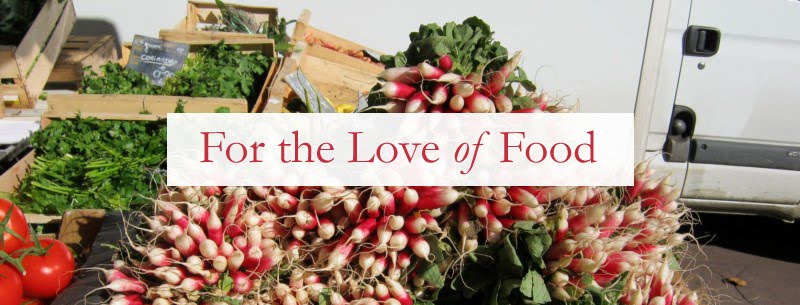Although you might imagine them to be exotic or difficult, the Chinese recipes I've tried are actually quite easy. What they rely on is a well-stocked pantry: you need some basics such as different kinds of soy sauce, chile pastes, fermented vegetables, toasted sesame oil, etc., but once you have those items the actual preparations are quite simple. For the past few months I'd sort of fallen out of the habit of cooking Asian, and that was because during my last move, I misplaced my precious stash of special ingredients. When I started my internship at Serious Eats, whose offices are located in Manhattan's Chinatown, it was the perfect occasion to restock my cabinets.

Some staples I picked up recently included (from left): fermented broad bean chile paste; Chianking, or black, vinegar; Shaoxing cooking wine; and potato starch (whose silky texture and un-gloppiness I prefer to cornstarch). Don't you love the packaging? So colorful.

Speaking of great packaging, check out these preserved Szechuan vegetables. Drool and an enthusiastic thumb's-up? Now that's great advertising!
Once I had all my go-to ingredients, I put them to good use making a recipe by one of the Serious Eats editors, Kenji Lopez-Alt. Kenji's no slouch when it comes to perfecting recipes: in addition to years of restaurant experience, he's got a stint as editor at Cook's Illustrated under his belt. Having tasted some of the delicious dishes he's whipped up in our office kitchen, such as bok choy and black bean chow fun and tonkotsu ramen, I knew I could trust his recipe for braised eggplant and tofu in garlic sauce. The best tip I learned from this recipe was to steam the eggplant first: sometimes, eggplant takes a long time to break down and become soft and creamy, and getting it to do so often requires a lot of hot oil. The pre-steam allows the eggplant to soften before it gets incorporated into the stir-fry:

Next, I fried up some aromatics: garlic, ginger, scallions, and the preserved vegetables. This right here is why I love Chinese cooking: look at all the flavor packed in there! It doesn't really matter what you add next--that oil has so much going on, anything cooked in it is going to be good:

The steamed eggplant and some diced firm tofu get fried up in here, then cooked down with a richly flavored sauce made up of soy, vinegar, cooking wine, brown sugar and chile paste. Behold, the finished dish:

Braised Eggplant with Tofu in Garlic Sauce
Adapted slightly from seriouseats.com
Serves 4
*Note: visit your local Asian grocery before making this recipe: many of the ingredients are not available at the supermarket.
Ingredients:
- 4 small or 2 large Japanese/Asian eggplants, rinsed and cut into large chunks
- 3 tsp. Chianking vinegar
- 1/2 c. Shaoxing cooking wine
- 1 tbsp. potato starch
- 4 tbsp. soy sauce
- 2 tbsp. brown sugar
- 1 tbsp. fermented broad bean chile paste
- 1 tbsp. sesame oil
- 2 tbsp. vegetable oil
- 2 cloves of garlic, smashed and peeled, plus 4 more cloves, minced or thinly sliced
- A 1-inch nub ginger, peeled and minced or grated
- 3 scallions, thinly sliced, whites and greens separated
- 2 tbsp. Chinese preserved vegetables, minced
- 1 package firm tofu, excess water squeezed out, cut into medium chunks
- 3 tbsp. chopped cilantro
Preparation:
1. Place eggplant in a large bamboo steamer set over a wok filled with 2 inches of water. Bring to a boil over high heat, reduce to a simmer, cover steamer, and cook until eggplant is completely tender, about 15 minutes. Set aside. (If you don't have a bamboo steamer, you can use a steamer insert in a large pot of water.)
2. Make the sauce: in a bowl, combine vinegar, wine, potato starch, soy, brown sugar, chile paste and sesame. Whisk until completely smooth.
3. Wipe out wok. Add oil and whole garlic cloves and cook over medium heat, turning garlic occasionally, until it is browned and fragrant. Remove garlic and discard.
4. Turn heat to high and add minced garlic and ginger, scallion whites, and preserved vegetables. Cook, stirring, about one minute, then stir sauce to recombine, and add to wok. Add eggplant and tofu and stir gently to combine. Bring to a boil, reduce to a simmer, and cook, stirring occasionally until thick and glossy, about 10 minutes longer. Garnish with scallion greens and cilantro and serve immediately with white rice.




1 comment:
Lauren, this looks amazing. You photo has me imaging the tantalizing aroma. I'm heading out to stock my pantry with the Asian flavor treasures you recommend. I keep you " posted" on how this turns out in my kitchen. LisaZ
Post a Comment